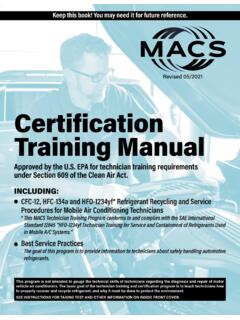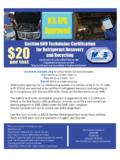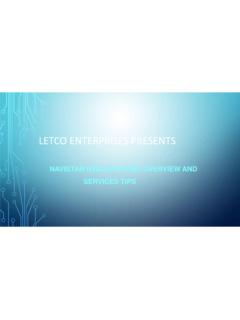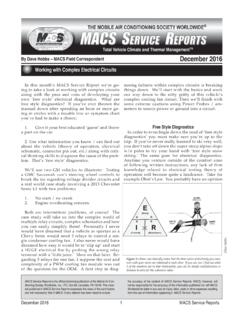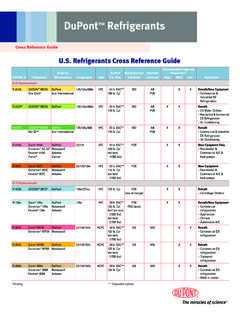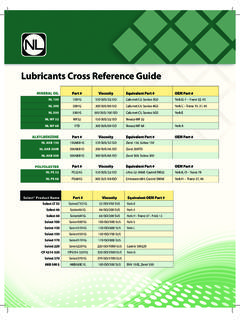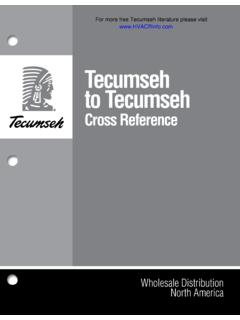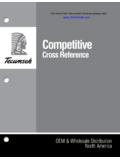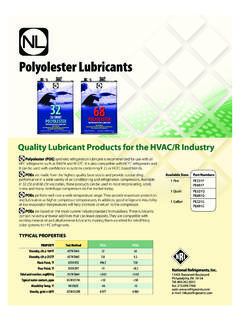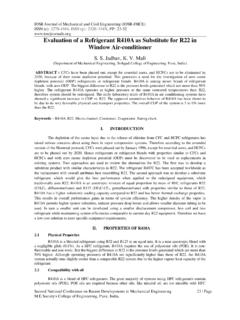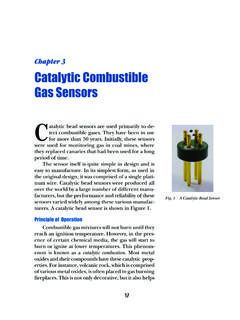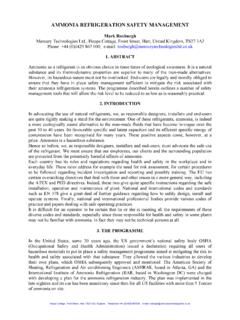Transcription of Certification Training Manual - MACS WorldwideHome
1 Certification Training ManualThis program is not intended to gauge the technical skills of technicians regarding the diagnosis and repair of motor vehicle air conditioners. The basic goal of the technician Training and certifi cation program is to teach technicians how to properly recover and recycle refrigerant, and why it must be done to protect the environment. SEE INSTRUCTIONS FOR TAKING TEST AND OTHER INFORMATION ON INSIDE FRONT : CFC-12, HFC-134a and HFO-1234yf* Refrigerant Recycling and Service Procedures for Mobile Air Conditioning Technicians*This MACS Technician Training Program conforms to and complies with the SAE International Standard J2845 HFO-1234yf Technician Training for Service and Containment of Refrigerants Used in Mobile A/C Systems. Best Service PracticesThe goal of this program is to provide information to technicians about safely handling automotive 1/2018 Keep this book!
2 You may need it for your by the EPA for technician Training requirements under Section 609 of the Clean Air Training Manual 2018 MOBILE AIR CONDITIONING SOCIETY WORLDWIDE Important Notes! Do not mix up tests or exchange tests with other individuals at your place of business. All tests are coded with names matching assigned numbers. Please review your test upon completion. Any questions marked with more than one answer will be scored as incorrect. Any question not marked will be scored as incorrect. Completely fi ll in the block ( ) to the left of the correct answer. Do NOT mark with a check ( ) or an x ( ).General Information and InstructionsYou have registered for MACS certifi cation in REFRIGERANT RECYCLING & SERVICE PROCEDURES FOR MOBILEAIR CONDITIONING TECHNICIANS. Following are the steps* necessary for you to complete the prescribed Training :1.
3 Read the instruction Manual that came with your recovery/recycling service equipment (and review the Training video, if provided). Then read this Manual cover to cover. Re-read as necessary to gain full comprehension of the material Take the test. The test is an untimed, open-book test, so you may refer to the Training Manual as often as necessary to research answers to the questions posed. (Note, however, that you must correctly answer a minimum of 21 of the 25 questions to earn certifi cation.) You must complete the test by yourself, without assistance from anyone, and submit it for scoring. (See 4 below.)3. Complete and sign the Identifi cation and Statement of Testing Conditions block on your test. Note: A reprint charge will be incurred if information provided is not Mail your test in the self-addressed envelope provided to: MACS-EIF, Box 88, Lansdale, PA 19446, or submit MACS-EIF will advise MACS of your test MACS will advise you of your score and, providing that you have attained a passing score, will issue a certifi cate and a wallet-sized card, indicating that you have successfully completed this MACS certifi cation Training Persons not attaining a passing score on the fi rst test will receive one retest at no additional charge.
4 If the test was originally ordered via phone, fax or mail, the second test will be sent via mail. If the original test was ordered online, the second test will also be online. If a passing score is not attained on the second test, the process begins again with a new test : Test with identifi cation information to be mailed to scoring facility. Self-addressed return envelope (MACS-EIF).Important - Please note: Tests must be returned for scoring within 90 days of the date they are issued. MACS assumes no responsibility for tests submitted for scoring after this 90-day period. MACS will charge an additional fee for re-issuing tests which are lost, misplaced or destroyed.* The following instructions apply to technicians taking the MACS Training course by mail or online. Those participating in a classroom program should follow the instructions of their trainer/proctor.
5 Tests given in a classroom setting must be closed-book tests. The required score for passing closed-book tests is lower than that required for passing the open-book : The MACS Worldwide offi ce is open from 8:30 until 5:00 Eastern Time. 2018 MOBILE AIR CONDITIONING SOCIETY WORLDWIDE Certification Training MANUALIThis publication is protected under the copyright laws of the United States and all other applicable international laws and treaties. All rights are reserved, including resale rights. No part of this publication may be reproduced or transmitted in any form, by any means (electronic, pho-tocopying, recording, or otherwise) without the prior written permission of Mobile Air Conditioning Society Worldwide (MACS Worldwide). Unauthorized use, reproduction or distribution of this publication, or any portion of it, may result in severe civil and criminal penalties, and will be prosecuted to the maximum extent possible under the law.
6 If you received this publication from anyone other than MACS Worldwide, then you have received a pirated copy. We would appreci-ate it if you would notify us of the situation. The information contained in this publication is based on technical data and tests, and is intended for use by persons with technical skill at their own discretion and risk. While the author(s) and publisher have made every reasonable effort to insure the accuracy of the infor-mation in this publication, they assume no responsibil-ity for errors or omissions. Please remember that your particular situation may differ from any examples illus-trated here, and so you should adjust your use of the information and any recommendations in this publica-tion accordingly. MACS Worldwide makes no representations or warranties concerning the information contained herein or the ap-plications described or referred to in this publication.
7 MACS Worldwide specifi cally disclaims any implied war-ranties, including the warranties of merchantability or fi tness for any particular purpose. MACS Worldwide shall in no event be liable for any loss of profi t, business in-terruption or any other commercial damage, including without limitation, special, incidental, consequential, or other damages arising out of the use or inability to use the presentations or applications described or re-ferred to herein. The identifi cation of any product, technique, fi rm or business entity in this publication does not consti-tute an endorsement by MACS Worldwide. Any company names, products, product names, emblems, logos, im-ages, trademarks, service marks or trade dress appearing in this publication are the property of their respective owners and are used solely in an editorial fashion.
8 All such items are protected under federal laws of the Unit-ed States and international agreements; unauthorized use is you wish to contact MACS Worldwide about this pub-lication, please refer to the information listed Box 88 225 S. Broad Street Lansdale, Pa, 19446 Voice: 215-631-7020 Fax: 215-631-7017E-mail: Website: MACS and the MACS logo are registered trademarks of the Mobile Air Conditioning Society Rights Reserved. Printed in the 1990, 2008, 2011, 2013, 2014, 2015, 2016, 2018 Mobile Air Conditioning Society WorldwideIICERTIFICATION Training Manual 2018 MOBILE AIR CONDITIONING SOCIETY WORLDWIDE FOREWORDW orld vehicle manufacturers are currently required to meet international regulatory requirements to use lower global warming potential (GWP) refrigerants in new vehicle A/C systems. This MACS Technician Training Program conforms to and complies with the SAE International standard J2845, HFO-1234yf Technician Training for Service and Containment of Refrigerants Used in Mobile A/C Systems.
9 Some of the practices, techniques, procedures, tools, information and equipment required to service HFO-1234yf and other alternative refrigerant systems are different from those commonly used on CFC-12 and HFC-134a systems. No technician should perform service or repair on a mobile air conditioning system without being trained to handle the refrigerant the system SAE standards are voluntary and developed through industry consensus, historically the Environmental Protection Agency has incorporated SAE standards into federal regulations by reference. Additionally, some individual states require compliance with SAE standards, particularly those related to safety. For example, many states refer to SAE J639, Safety Standards for Motor Vehicle Refrigerant Vapor Compression Systems in various laws and regulations. MACS Worldwide acknowledges and thanks the EPA, SAE International, and the industry s many manufacturers and suppliers who allowed their data and products to appear in this J639: Safety Standards for Motor Vehicle Refrigerant Vapor Compression SystemsIssuing Committee: SAE International Interior Climate Control Steering Committee This SAE Standard applies to refrigerant vapor compression systems that provide cooling and/or heating for passenger cars, light trucks and commercial vehicles (on and off road) that use automotive type mobile air con-ditioning (MAC) systems.
10 Large trucks, buses and other vehicles that do not use typical automotive A/C systems or use refrigerants not listed in this document are not covered by this standard. This standard covers any vehicle with a MAC system using a belt or electric motor driven compressor. This document provides standards for design, assembly, test and service of MAC systems to minimize environ-mental, health and safety impacts. Also included are cautionary statements for the service industry to alert technicians to the inadvisability and possible health or safety effects associated with venting refrigerant during service. This document addresses only HFC-134a (R-134a), carbon dioxide (R-744), and HFO-1234yf (R-1234yf) refrigerants. To prevent system contamination, all refrigerants used in mobile air conditioning vapor compression systems require unique service fi ttings and service equipment.
